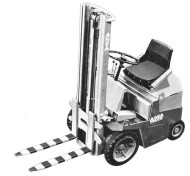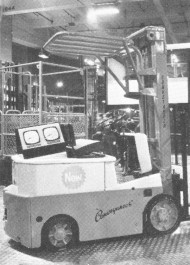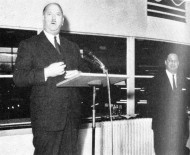 Warehouse & Logistics News is proud to bring you the forty-third instalment in our exclusive series on the history of the fork lift truck, the machine that over the decades has revolutionised the face of materials handling around the world.
Warehouse & Logistics News is proud to bring you the forty-third instalment in our exclusive series on the history of the fork lift truck, the machine that over the decades has revolutionised the face of materials handling around the world.
Our writer is James Brindley, an acknowledged authority on fork lift trucks. James’s distinguished career has involved engineering and management roles with BT Rolatruc and serving as a Director of the Fork Lift Truck Association, before he set up the National Fork Truck Heritage Centre in 2004 as Britain’s first such collection open to the public.
The Heritage Centre continues to need your support in 2009, and if you or your company would like to help in any way, you can contact James on the number below. Now sit back and enjoy the latest part of this fascinating series.
Episode 43: 1964: A spirit of rising optimism
1963 saw UK unemployment declining, production increasing and Britain maintaining its share of overseas markets. So many reasonably assumed 1964 could be even better. In this spirit the Ninth Mechanical Handling Exhibition took place at Earls Court in London. Dr, Richard Beeching of the Railway Board opened the show with the words: “I think this is one of the most useful industrial exhibitions organised in this country, because it covers a field of considerable interest and importance to virtually every industry – manufacturing; the extractive industries; the service industries; the wholesale retail distributive trades and almost anybody who employs people to do physical work.” (Author’s note: no guesses what Dr Beeching did next – axed over 4,000 railway route miles on cost and efficiency grounds.)
 Exhibitors reported large numbers of visitors to their stands, a high proportion coming from abroad to see the improvements and innovations to equipment at first hand. One such advance was in truck speed control systems, demonstrated by some manufacturers with the fitting of stepless control.
Exhibitors reported large numbers of visitors to their stands, a high proportion coming from abroad to see the improvements and innovations to equipment at first hand. One such advance was in truck speed control systems, demonstrated by some manufacturers with the fitting of stepless control.
Clark had first introduced stepless control by the use of a carbon pile resistor system in 1962, and Stacatruc were now adopting it on their narrow straddle pantograph truck and on a number of Elpar Union trucks, made under licence by Wessex Industries of Poole in Dorset. The “Union” marque was added to the Wrigley range from March 1964.
On some other makes of battery operated fork lifts new technology was starting to forge ahead with the introduction of the transistor and thyristor in operating control systems. No less than five major manufacturers were offering the electronic option, including Yale, Conveyancer, Lansing Bagnall, ASEA-Jimmy and Hyster Ransomes.
 Among Yale’s new models was the “Super Series 51” battery operated fork lift truck with “Econtrol”. This was the brand name of their electronically controlled drive, described by the company as “an infinitely variable speed control that permits the driver to inch the truck smoothly during stacking operations and thus control the load much better at greater heights.”
Among Yale’s new models was the “Super Series 51” battery operated fork lift truck with “Econtrol”. This was the brand name of their electronically controlled drive, described by the company as “an infinitely variable speed control that permits the driver to inch the truck smoothly during stacking operations and thus control the load much better at greater heights.”
Conveyancer used the “Pulsomatic” control system developed by Cableform Ltd for their trucks, and pointed out the simplicity of servicing in their sales brochure. It was also claimed that with this system the engineer would be able to identify a fault with simple voltmeter checks and use replacement plug-in units to limit truck down time.
Lansing Bagnall, on the other hand, highlighted their “Hytronic” system’s benefit of battery economy in their selling strategy. The company claimed that by adapting their existing system of regenerative braking to s.c.r. control, it was able to produce a system that afforded even greater battery economy than achieved by pulse control alone. Lansing Bagnall’s first truck to demonstrate the system was their new TOER tractor.
 Asea of Harnosand Sweden launched two new fork lifts with electronic control systems. Models GEC 961, with a lifting capacity of 2,204lbs on cushion tyres and GEL 1361, with a lifting capacity of 3,300lbs on pneumatic tyres were both fitted with “Thyrodrive.” The company’s claims for this new form of drive system stated that the truck only consumed enough battery power for the immediate travelling speed. Thus by using “Thyrodrive” the truck would cover 33 per cent more distance on a single battery charge than a similar truck fitted with resistance control.
Asea of Harnosand Sweden launched two new fork lifts with electronic control systems. Models GEC 961, with a lifting capacity of 2,204lbs on cushion tyres and GEL 1361, with a lifting capacity of 3,300lbs on pneumatic tyres were both fitted with “Thyrodrive.” The company’s claims for this new form of drive system stated that the truck only consumed enough battery power for the immediate travelling speed. Thus by using “Thyrodrive” the truck would cover 33 per cent more distance on a single battery charge than a similar truck fitted with resistance control.
By James Brindley, Director, National Fork Truck Heritage Centre
If you would like to support the National Fork Truck Heritage Centre, please call James Brindley on 0780 195 4167




Comments are closed.